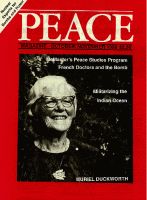
Peace Magazine Oct-Nov 1988, page 7. Some rights reserved.
Search for other articles by Bruce Allan here
ON THIS, my third visit to Fast Berlin, I was intrigued by changes showing the German Democratic Republic's (GDR's) superficial acceptance of Soviet bloc reforms. Gone from the border points were the stern, business-like Prussian goons who had manned (sic) them five years ago. In their place now stand polite, smiling young East Germans who are even capable of humor. Likewise, in East Berlin the police presence is less obvious. The city, affluent by East bloc standards, has a vibrant night life. These changes make a visit actually worth the 30 West German marks that the border control take you for as you enter. Not everything about East Berlin has changed. Away from the glitz of Alexanderplatz and the nightspots along the nearby "Unter den Linden," the city is as sterile and unimpressive as ever. But even this tedium is superficial. Beneath it are some remarkable things that are not meant to be seen by visitors. They show a resistance movement that boldly nurtures a new civil society, in open defiance of the neo- Stalinist East German state.
In a single day I saw two memorable expressions of this. One was the annual Berlin Peace Workshops, hosted by the city's Protestant Evangelical Church. The other was an evening of poetry at the Art Gallery of the Independent Ecology Library.
The peace workshops took place in a suburban church. Almost a thousand persons came, proving the breadth of support behind the independent peace and ecology groups, whose appearance some six years ago marked the emergence of social resistance in the GDR. Also present were both uniformed and plainclothed members of the People's Police. This did not seem to matter. Their presence was taken for granted and they refrained from disrupting this gathering, which brought Berliners and others together to indulge in politics, theatre, and music.
HIS EVENT WAS strikingly similar to peace and alternative political gatherings in the West. Feminists and gays were there with displays and tables, as were ecology groups, conscientious objectors to military service, people working in solidarity with the liberation struggle in South Africa and still others expressing solidarity with Nicaragua. Absent were activists from the West, except myself. It shows how mighty a barrier the Berlin Wall is.
I attended with my Fast German friends Ulrike and Gerd Poppe, of the Berlin-based group, "Initiative Peace and Human Rights." They said the attendance was smaller than the heady days of 1982 or 1983 when the autonomous peace movement burst onto the East German scene. Back then, 3000 people would have turned up. However, Ulrike reassuringly denied that attendance at such events measured the strength of the movement.
That evening I went to the Ecology Library at East Berlin's Church of Zion. What I saw there bore out Ulrike Poppe's observation and showed why the GDR authorities have angrily labelled the Church of Zion a "Centre of Subversion."
The complex that houses this "subversion" comprises several rooms. Adjoining the Library's art gallery is a beverage and food stall, with chairs around tables full of reading material. One finds official and unofficial East German publications, as well as radical West German material, such as the daily Tageszeitung. In another part of the church is a basement library stocked with books about ecology, anti-militarism, critical Marxism (such as Hungary's Lukas) and documents from the Fast German alternative political scene. In a work area I saw stacks of uncollated pages of the Umweltblaetter (Environmental Pages) on a table under a red, black, and white poster quoting Rosa Luxemburg's critical book on the Bolshevik Revolution.
I spent most of the evening in the art gallery area. The program featured poetry reading. Yet such an event attracted at least 60 young people, almost all under 25. Many were from East Germany's punk scene. For the entire evening everyone present sat in silence, intensely listening. This, plus the enthusiastic response that an alternative theatre group from Leipzig had received earlier in the day at the peace workshops, made it plain to me why the GDR's authorities have been both fearful and iron-fisted in dealing with their critics within the cultural intelligentsia. These cultural works boldly challenge a state apparatus that must try to control East German social life in order to preserve the ruling Socialist Unity Party's monopoly of power.
As far as I could tell, none of these young people had been at the peace workshops earlier in the day. This showed the scale of the alternative scene in East Berlin, which also exists, to varying degrees, in cities and towns across the GDR. Truly, the East German authorities have cause for concern for what this implies for them. We in the Western peace and ecology movement have equal reason for excitement about the strength and the Green political character of the East German peace movement. ~
Bruce Allen is a member of ACT for Disarmament.

Peace Magazine Oct-Nov 1988, page 7. Some rights reserved.
Search for other articles by Bruce Allan here